Gallery
- Scottish red deer (subspecies)
- Irish elk (extinct)
Six species of deer are living wild in Great Britain: [1] Scottish red deer, roe deer, fallow deer, sika deer, Reeves's muntjac, and Chinese water deer. [2] Of those, Scottish red and roe deer are native and have lived in the isles throughout the Holocene. Fallow deer have been reintroduced twice, by the Romans and the Normans, after dying out in the last ice age. The other three are escaped or released alien species.
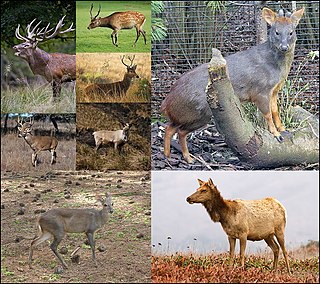
Deer or true deer are hoofed ruminant mammals forming the family Cervidae. The two main groups of deer are the Cervinae, including the muntjac, the elk (wapiti), the red deer, and the fallow deer; and the Capreolinae, including the reindeer (caribou), white-tailed deer, the roe deer, and the moose. Male deer of all species as well as female reindeer, grow and shed new antlers each year. In this they differ from permanently horned antelope, which are part of a different family (Bovidae) within the same order of even-toed ungulates (Artiodactyla).

The roe deer, also known as the roe, western roe deer, or European roe, is a species of deer. The male of the species is sometimes referred to as a roebuck. The roe is a small deer, reddish and grey-brown, and well-adapted to cold environments. The species is widespread in Europe, from the Mediterranean to Scandinavia, from Scotland to the Caucasus, and east to northern Iran and Iraq.

The sika deer, also known as the Northernspotted deer or the Japanese deer, is a species of deer native to much of East Asia and introduced to other parts of the world. Previously found from northern Vietnam in the south to the Russian Far East in the north, it is now uncommon except in Japan, where the species is overabundant.

Game or quarry is any wild animal hunted for animal products, for recreation ("sporting"), or for trophies. The species of animals hunted as game varies in different parts of the world and by different local jurisdictions, though most are terrestrial mammals and birds. Fish caught non-commercially are also referred to as game fish.

Muntjacs, also known as the barking deer or rib-faced deer, are small deer of the genus Muntiacus native to South Asia and Southeast Asia. Muntjacs are thought to have begun appearing 15–35 million years ago, with remains found in Miocene deposits in France, Germany and Poland. Most species are listed as Least Concern or Data Deficient by the IUCN, although others such as the black muntjac, Bornean yellow muntjac, and giant muntjac are Vulnerable, Near Threatened, and Critically Endangered, respectively.
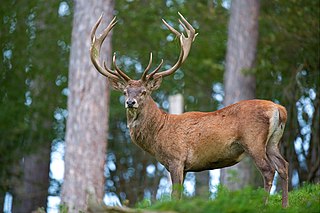
The red deer is one of the largest deer species. A male red deer is called a stag or hart, and a female is called a hind. The red deer inhabits most of Europe, the Caucasus Mountains region, Anatolia, Iran, and parts of western Asia. It also inhabits the Atlas Mountains of Northern Africa; its early ancestors are thought to have crossed over to Morocco, then to Algeria, Libya and Tunisia via the Strait of Gibraltar, becoming the only species of true deer (Cervidae) to inhabit Africa. Red deer have been introduced to other areas, including Australia, New Zealand, the United States, Canada, Peru, Uruguay, Chile and Argentina. In many parts of the world, the meat (venison) from red deer is used as a food source.

The Veluwe is a forest-rich ridge of hills (1100 km2) in the province of Gelderland in the Netherlands. The Veluwe features many different landscapes, including woodland, heath, some small lakes and Europe's largest sand drifts.

Reeves's muntjac, also known as the Chinese muntjac, is a muntjac species found widely in southeastern China and Taiwan. It has also been introduced in Europe and Japan. It takes its name from John Reeves, a naturalist employed by the British East India Company in the 19th century.
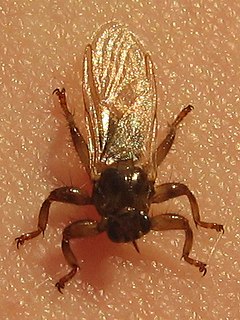
Lipoptena cervi, the deer ked or deer fly, is a species of biting fly in the family of louse flies, Hippoboscidae. These flies are commonly encountered in temperate areas of Europe, Siberia, and northern China. They have been introduced to North America. They are parasites of elk, deer, and other deer family members, burrowing through the fur and sucking the blood of the host animals. Adults are only 5–7 mm (0.20–0.28 in) in length and brownish in colour. Their bodies are flat and elastic, making their removal difficult. L. cervi is a poor flier and can only fly for short distances. Once the insect reaches its target, it sheds its wings and starts burrowing through the fur.
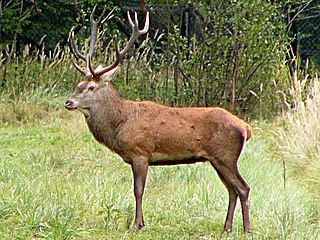
Cervus is a genus of deer that primarily are native to Eurasia, although one species occurs in northern Africa and another in North America. In addition to the species presently placed in this genus, it has included a whole range of other species now commonly placed in other genera. Additionally, the species-level taxonomy is in a state of flux.
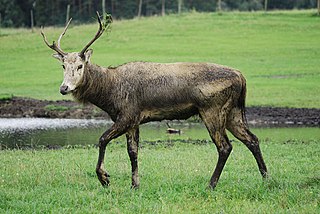
The Cervinae or the Old World deer, are a subfamily of deer. Alternatively, they are known as the plesiometacarpal deer, due to their ankle structure being different from the telemetacarpal deer of the Capreolinae.

Deer hunting is hunting for deer for meat and sport, an activity which dates back tens of thousands of years. Venison, the name for deer meat, is a nutritious and natural food source of animal protein that can be obtained through deer hunting. There are many different types of deer around the world that are hunted for their meat. For sport, often hunters try to kill deer with the largest and most antlers to score them using inches. There are two different categories of antlers. They are typical and nontypical. They measure tine length, beam length, and beam mass by each tine. They will add all these measurements up to get a score. This score is the score without deductions. Deductions occur when the opposite tine is not the same length as it is opposite. That score is the deducted score.

The island of Great Britain, along with the rest of the archipelago known as the British Isles, has a largely temperate climate. It contains a relatively small fraction of the world's wildlife. The biota was severely diminished in the last ice age, and shortly thereafter was separated from the continent by the English Channel's formation. Since then, humans have hunted the most dangerous forms to extinction, though domesticated forms such as the dog and the pig remain. The wild boar has subsequently been reintroduced as a meat animal.
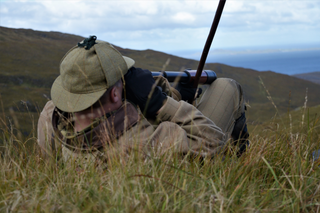
Deer stalking, or simply stalking, is a British term for the stealthy pursuit of deer on foot with the intention of hunting for meat, for leisure/trophy, or to control their numbers. As part of wildlife management, just as with rabbiting and boar hunting, the aim of deer stalking is to help reduce crop damage and obtain venison. Also, as with other types of hunting, deer stalking has long been considered a pastime sport.
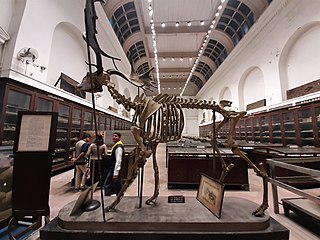
There are four species of deer living wild in Ireland today, namely red deer, fallow deer, sika deer, and the recently introduced Reeve's muntjac, which is becoming established. Recently, roe deer have been spotted in county Wicklow and county Armagh. The Irish elk and the Red Deer both became extinct in Ireland about 10,500 years ago during the Nahanagan Stadial. The reindeer was extirpated from Ireland about 9500 years ago. Many of their skeletal remains have been found well preserved in peat land.
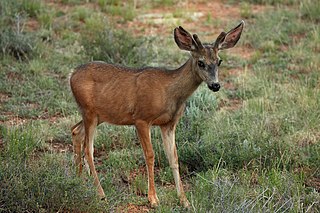
The Capreolinae, Odocoileinae, or the New World deer are a subfamily of deer. Alternatively, they are known as the telemetacarpal deer, due to their bone structure being different from the plesiometacarpal deer subfamily Cervinae. The telemetacarpal deer maintain their distal lateral metacarpals, while the plesiometacarpal deer maintain only their proximal lateral metacarpals. The Capreolinae are believed to have originated in the Middle Miocene, between 7.7 and 11.5 million years ago, in Central Asia.

Animals of Wales includes marine and land animals, birds and reptiles that are resident, visitors or have been introduced to Wales.
An ornamental animal is an animal kept for display or curiosity, often in a park. A wide range of mammals, birds and fish have been kept as ornamental animals. Ornamental animals have often formed the basis of introduced populations, sometimes with negative ecological effects, but a history of being kept as ornamental animals has also preserved breeds, types and even species which have become rare or extinct elsewhere.